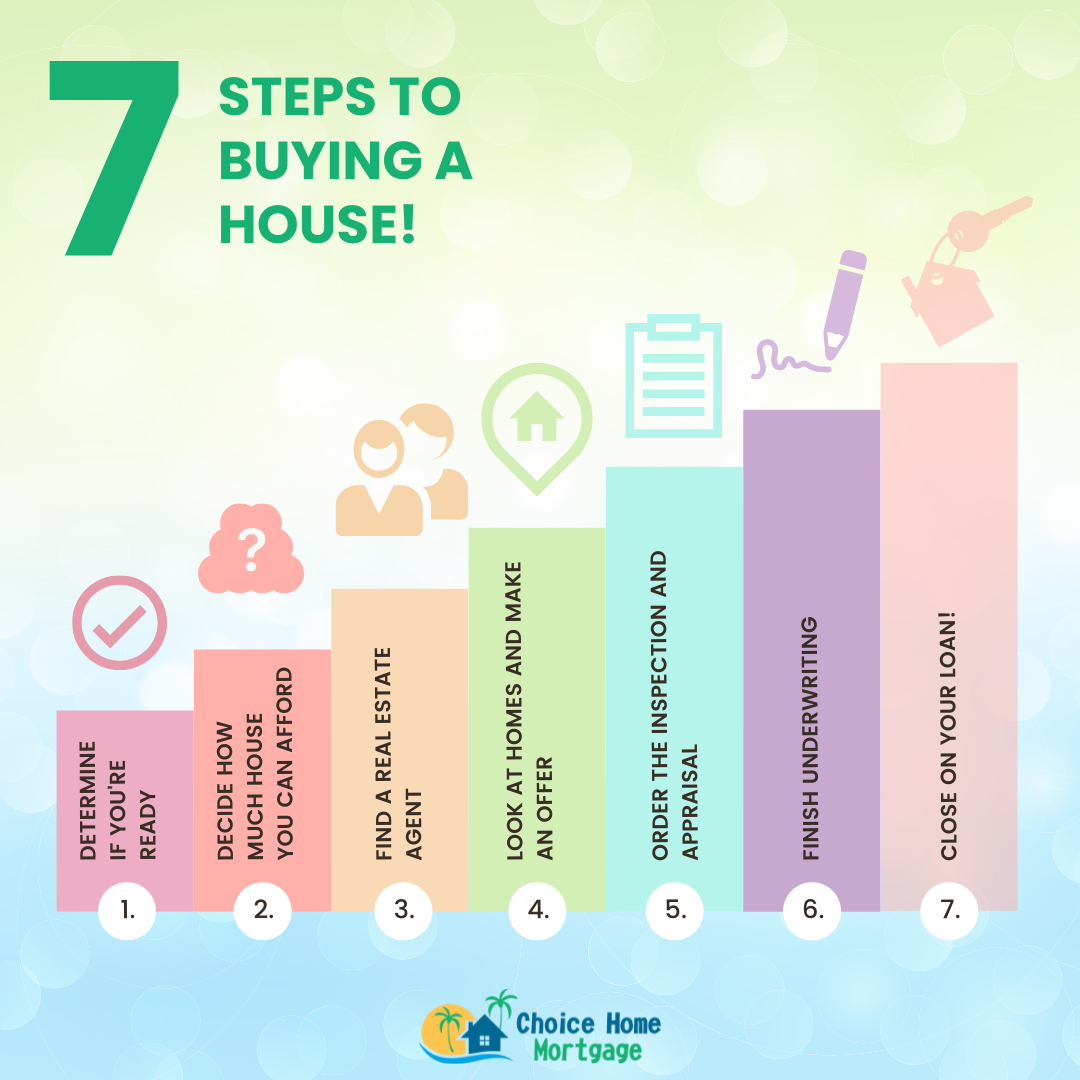Table of Contents
Buying a home can be fun and stressful at the same time. You’re searching for your dream house – the place you will call home with your family for at least the next few years, if not forever. It’s a big job!
The buying process can take many months and involves many steps, some of which you should take long before you even look at homes.
Here are the key steps in buying a house to make it as stress-free and successful as possible for you.
Step 1: Determine if you’re Ready to Buy a Home
Before you buy a house, you should determine if you’re ready. A house is likely one of the largest commitments and investments you’ll make in your lifetime so it’s important to take the time to make sure the timing is right.
What is your Credit History?
Your credit history is the first thing lenders look at when deciding if you qualify for a loan. Bad credit history can make it hard to get approved. If you do get approved, it may be at a higher interest rate or worse terms.
Pull your free credit report and see if you have any negative credit information, such as:
- Late payments (any payments made over 30 days late)
- Credit cards or credit lines with over 30% of the credit line outstanding
- Collections
- Public records (bankruptcy or foreclosure)
- Excessive use of revolving debt (credit cards)
You may also see your credit score for free if you sign up for Experian or use your free credit reporting options from any of your credit cards or even bank accounts.
Ideally, you should have a 660 or higher credit score, but you may get away with a lower score in some cases. Look at your credit history and decide if it’s in good enough shape or if you have enough credit. Some people have a ‘thin’ credit profile and don’t qualify because lenders don’t have enough information to use to make a decision.

Is your Income and Employment Stable?
Lenders look at your last two years to see if your income and employment are stable. This doesn’t mean you can’t change jobs during that time, but you should be able to show stability.
Ask yourself, are you in your career, or are you still trying to figure out what you want to do? Income stability is key to affording a home. Even if you can afford the payment now if you don’t have stable employment, how will you afford it in the future?
Are your Debts Under Control?
Your debt-to-income ratio is another major factor in your loan approval. If you have too many debts, you may not be able to afford the mortgage.
Lenders look at your debt-to-income ratio, which compares your total monthly debts to your gross monthly income (income before taxes). Ideally, your DTI should be 49% or less, but some loan programs allow a DTI of over 50% in certain situations.
It’s a good idea to calculate your DTI to determine if you should pay any debts off before you apply for a mortgage. Remember, your DTI includes the new mortgage payment, so make sure to include an estimated payment in your calculations.
If your DTI is too high, work out a debt repayment plan before you apply for a mortgage to get your DTI to a manageable level.
Do you Have Enough Assets?
You’ll need money to put down on your home and money for the closing costs. You must be able to prove that you have the funds in your possession and the money didn’t come from a loan.
Your assets must be liquid, such as in a checking, savings, CD, or stocks you can sell right away. In other words, you must have immediate access to the funds or liquid assets that you can sell to use for the down payment and closing costs.
Down Payment Funds
Most loan programs require a down payment starting at 3% or more. You must prove you have the funds in your bank account and that the funds belong to you.
While some loan programs don’t require a down payment, such as VA and USDA loans, it’s always best to prepare with a down payment. Even if a program doesn’t require it, making a down payment gives you instant equity in your home and may give you access to lower interest rates or better terms.
Closing Costs
Closing costs are something many homebuyers overlook. The total cost can be 2% – 5% of your loan amount. It varies by borrower and lender, but it’s a good idea to work them into your budget so you have enough liquid assets available when you’re ready to apply for a loan.
Interested in purchasing a home?
Step 2: Determine how much House you can Afford
To determine how much house you can afford, it’s best to get pre-approved for a mortgage. A pre-approval will tell you how much a lender will lend you, what the payment is, and the total cost of the loan.
You don’t have to borrow the full amount you’re pre-approved for, but you’ll know the maximum amount we can offer.
You can use the payment, which will include principal, interest, real estate taxes, and homeowner’s insurance to see how it fits within your budget. We won’t pre-approve you for any amount that exceeds the general debt-to-income ratio guidelines, which can range from a 36% DTI to a 50% DTI depending on the loan program.
Documents Needed to Get Pre-Approved
To get pre-approved, you’ll need to provide the following documents:
- Paystubs covering the last 30 days of employment
- W-2s for the last 2 years
- Tax returns for the last 2 years if you’re self-employed
- Bank statements for the last 2 months
- Proof of employment
- Letters of explanation for any gaps in employment or negative credit in the last 2 years
Using your Pre-Approval Letter
Once you’re pre-approved for a loan, we’ll issue a pre-approval letter. The letter will state how much loan you can borrow, the type of mortgage program, the required down payment, and the loan terms.
The letter will also state what conditions you must satisfy to close on the loan, which will include conditions about the property you choose too.
Step 3: Find a Real Estate Agent
Your next step is to find a real estate agent. They can be instrumental in helping you find the right home and pay the right price.
We suggest interviewing at least three real estate agents to see which one fits your needs. Each agent has a different philosophy and methods to handle the home search. Find an agent that works with clients like you, communicates in the way you prefer and is good at what they do.
Some questions to ask real estate agents include:
- How long have you been doing this?
- What types of homes do you help clients buy/sell?
- How do you communicate new listings that you find?
- How often do you contact your clients?
- How long does it take to find your clients their ‘dream home’?
Step 4: Look at Homes and Make an Offer
It’s finally time to look at homes and make an offer on them. Your real estate agent can help you find the homes that fit your needs and even your wants. Together you can discuss the pros and cons of each home, and then ultimately decide.
Once you find ‘the home,’ you can make an offer. Your real estate agent will handle this for you. Of course, the offer should be within your pre-approved amount including the amount of the down payment you will make.
Determining the Terms of the Sale
When you make an offer, you’ll make it based on many factors including not only the price, but also the contingencies you want to include, the closing date, and the earnest money deposit.
Contingencies
Contingencies are terms of the sale that give you a ‘way out’ of the contract without losing your earnest money. A common contingency is the home sale contingency. It gives you the right to back out of the contract if you can’t sell your home by the specified date.
Other contingencies include a home inspection, home appraisal, or financing contingency. Each option gives you a way out of the contract if you can’t meet the terms. But the more contingencies you have, the less likely a seller is to accept your offer.
Closing Date
The closing date is when you propose to have your financing in order and can take possession of the house. Every seller has a different timeline, so it helps to know what they need when proposing a closing date.
Earnest Money
The final part of your contract is your earnest money. This is the amount you promise to put down in an escrow account. If you back out of the contract for a reason other than a contingency, you will forfeit the earnest money, giving it to the seller. This shows sellers how serious you are about buying the house.
Step 5: Order the Inspection and Appraisal
Once you have an executed sales contract on a property, you can order the inspection and appraisal. An inspection isn’t required to get loan approval, but it can protect your investment.
If the home has major issues, you may want to request that the seller fix the issues, renegotiate the contract, or you may want to back out of the sale altogether.
The appraisal is required by lenders as it determines the home’s value. It’s what we use to determine your loan amount. The home must be worth at least as much as you’re borrowing. If it’s not, you have a few options:
- Renegotiate the sales price to meet the appraised value
- Pay the difference between the sales price and appraised value
- Back out of the sale
Step 6: Finish Underwriting
While you wait for the appraisal, you can satisfy your other conditions. Using your pre-approval letter, determine what is needed to clear your loan to close.
The underwriter will take care of clearing the property’s conditions, including ordering the appraisal and title work.
Your job is to provide any outstanding documentation, keep your credit in good standing, and don’t make any major financial changes.
Verifying your Conditions Before Closing
Right before the closing, the underwriter will pull your credit again, reverify your employment, and check your assets.
To keep your approval, make sure you take care of your credit, don’t change jobs, and don’t make any large deposits or withdrawals from your bank accounts.
Communicate with your Loan Officer
In the meantime, make sure you stay in contact with your loan officer. He/she is the key to communicating any outstanding conditions or documents. The faster you can satisfy any conditions, the faster you’ll get to the closing table.
Step 7: Close on your Loan
Your final step is to close and become a homeowner! By the closing date, you’ll need a paid-in-full receipt for 12 months of homeowner’s insurance and a cashier’s check or wire for the amount of your down payment and closing costs.
At the closing, you’ll sign a stack of papers that include your new mortgage and note so you understand the obligation you’re taking on and the consequences of not paying your loan back.
Final Thoughts
These 7 steps help you navigate your way from thinking about buying a house to becoming a homeowner. With our support, you can buy your dream home and have a stress-free time securing your financing.
Our professionals are ready to help you understand your loan options, how to qualify for a loan, and to walk you through the process once you find your dream home and are ready to close on your loan.



